
66 Nguyen Anh Tuan, Phan Anh Nguyen, David Rockwood
IMPACTS OF CLIMATE CHANGE ON BUILDING PERFORMANCE AND
ADAPTATION SOLUTIONS
Nguyen Anh Tuan1, Phan Anh Nguyen1*, David Rockwood2
1The University of Danang - University of Science and Technology, Vietnam
2University of Hawaii at Manoa
*Corresponding author: panguyen@dut.udn.vn
(Received: August 27, 2024; Revised: September 26, 2024; Accepted: October 12, 2024)
DOI: 10.31130/ud-jst.2024.560E
Abstract - Climate change has had significant impacts on the
global climate, affecting the operational efficiency of buildings.
This study employs future climate prediction methods based on
the latest IPCC scenarios, using General Circulation Models
(GCMs) to forecast climate conditions in three regions of
Vietnam. Additionally, the study integrates simulation and
simulation-based optimization methods to project the rise in
greenhouse gas emissions and the level of thermal discomfort
(overheating) in commercial buildings in Vietnam. The findings
indicate that, due to the effects of climate change, carbon
emissions from commercial buildings in Vietnam could increase
by 6% to 22%, while the duration of overheating inside buildings
may rise by several tens to several hundred percent.
Key words - Climate change; energy simulation; carbon
emissions; commercial building; design solutions
1. Set the problem, necessity and significance of the
research
According to the assessment report of the
intergovernmental panel on climate change (IPCC)
published in March 2023, the warming of the earth is very
clear. The report of the Intergovernmental Committee on
Climate Change stated: Climate change is happening faster
than forecast. The report also proves that the earth's surface
and sea surface temperatures have increased by more than
0.48 °C compared to the period 1961 - 1990; global sea
levels also rose to a record high, reaching 3.2 mm/year,
double the level 1.6 mm/year of the 20th century.
In Vietnam over the past 70 years, the average annual
temperature has increased, on average 0.1 ºC/decade. The
average temperature of the decade 1991-2000 in Hanoi was
0.7ºC higher than the average temperature of many years
(1961-1990). Sea level observed at Cua Ong and Hon Dau
stations over the past 50 years shows that on average each
decade it has increased by 2.5-3.0 cm. According to
research by the Australian Agency for Science and Industry
for the Asia-Pacific region, it shows that: except for the
Northwest, Viet Bac and Central Highlands, all other
regions have increased temperatures corresponding to the
years 2010 and 2050 and 2075 are 0.3, 1.1 and 1.5ºC
respectively. The three remaining regions mentioned above
had larger increases of 0.5, 1.8 and 2.5ºC.
According to the "2020 Climate Change Scenario" of
the Ministry of Natural Resources and Environment of
Vietnam, the highest and lowest temperature increase can
reach 4.7°C and 4.1°C by the end of the century under the
RCP8.5 scenario; By 2100, the average sea level rise for
the entire East Sea region according to the RCP4.5 scenario
is 56 cm (38 cm ÷ 78 cm) and according to RCP8.5 it is
77 cm (51 cm ÷ 106 cm). The average sea level rise along
Vietnam's coast is likely to be higher than the global
average sea level. Therefore, Vietnam ranks high in the
group of countries most severely affected by the
consequences of climate change because of its long
coastline and its climate region located in the tropics.
In general, climate change increases extreme weather
events, strongly impacting people and ecosystems,
especially vulnerable components. The challenge for
building designers is how to mitigate impacts while cutting
greenhouse gas emissions from the construction and
operation of buildings. Facing such an urgent situation,
studying on the impact of climate change on construction
projects is an extremely necessary and appropriate content
in the current context. The research has two basic goals to
achieve as follows:
- How to assess the impact of climate change on
projects: Develop indicators to evaluate future projects
under climate change conditions.
- Impact assessment: Consider whether current design
solutions help the building withstand and adapt to climate
change and look for building design solutions that help the
building best adapt to changes of climate.
The research target of the study is commercial
buildings because this group of construction types is
currently experiencing rapid growth in recent times in
Vietnam, both in quantity and proportion of energy
consumption and the generation of greenhouse gas
emissions in buildings [1].
2. Literature review on climate change studies
In Vietnam, research on the impacts of climate change
mainly takes place in the fields of agriculture, irrigation
and human life. Scientific research on buildings under
climate change conditions is very limited. In 2013, the
book "Coping with climate change in industrial, urban and
construction activities" was published [2], in which chapter
4 is dedicated to "Coping with climate change in
architectural and construction activities". In 2015, we had
an initial study on climate change, biological comfort and
energy consumption - the challenges of design in the 21st
century [3], and this can be considered one of the initial
steps of the topic of climate change impacts on buildings
in Vietnam.

ISSN 1859-1531 - THE UNIVERSITY OF DANANG - JOURNAL OF SCIENCE AND TECHNOLOGY, VOL. 22, NO. 11C, 2024 67
The world's first publication on climate change and its
impacts on building projects probably began in 1994 [4].
The most frequently cited report in this field is probably
climate change and the indoor environment: impacts and
adaptation [5]. Although limited to the UK, it covers a wide
range of building types: 19th-century houses, new-build
houses, 1960s flats, new-build flats, offices... For houses,
Gaterell and McEvoy [6] present a study of the impact of
climate change on existing detached housing developments
in the UK, while Hacker et al. [7] include semi-detached
houses. Wang et al. [8] focused on a residential facility
building and various energy-saving variations in Australia,
while Chan [9] presented the case for Hong Kong. In the
office sector, Radhi [10] conducted a study on the impact
of climate change on air-conditioned building projects in
the United Arab Emirates, while Wan et al. [11] covered
including air-conditioned offices in China; Chan [9]
presents the situation in Hong Kong. Crawley [12] studied
the impact of climate change on a small office building, at
25 locations worldwide covered by his climate data
collection. The general conclusion of this study is that the
impact of climate change will lead to a reduction in energy
use of about 10% for buildings in cold climates, an increase
in energy use of up to 20% for buildings in tropics climates
and switch from heating to cooling energy in temperate
climates.
Regarding the future increase in energy consumption
due to climate change, Wan et al. [11] conducted a study
of Hong Kong offices in a subtropical climate; The results
show that office buildings have a 6.6% increase in total
energy consumption during the period 2091-2100 when
climate change scenarios B1 are applied (similar to the
RCP4.5 scenario in [13]). Dirks et al. [14] investigated the
impact of climate change on buildings in different climate
zones of the United States. They demonstrated that in the
hot, humid climate of Florida, office buildings would see a
15.2% increase in total energy consumption, while cold
and temperate climates could see a decrease. Another study
by Zheng and Weng [15] showed an average annual
increase in building energy demand of 7.9% under the
A1F1 climate scenario in 2050 for Los Angeles County.
The above-mentioned studies have reported increased
energy levels due to climate change, which are comparable
standards for the results of this study.
3. Research methods
3.1. Select climate change scenarios
Predicting future global climate change is a difficult
task and clear uncertainties always exist [13]. This study
decided to use the high emission scenario RCP8.5 to
evaluate the hypothetical impact of severe climate change
on buildings. The climate change impacts of RCP4.5 and
6.0 are quite similar in the short term (i.e. 2046-2065) with
a slightly larger impact of RCP4.5. However, in the long
term (i.e. 2081-2100) RCP4.5 has a slightly smaller climate
change impact than RCP6.0 due to the impact of climate
policies. This study decided to choose the RCP4.5 scenario
to represent the two intermediate scenarios of AR5. This
study chooses the AR5 emission scenario because
according to the "2020 Climate Change Scenarios" of the
Ministry of Natural Resources and Environment of
Vietnam, RCP (AR5) emission scenarios are built to
estimate the following scenarios: Climate change until the
end of the 21st century, along with roadmaps for publishing
IPCC reports on global climate change. The RCP4.5 and
8.5 scenarios have also been applied in previous studies by
Bilardo et al. [16] and Spandagos and Ng [17]. This choice
is also completely compatible with Vietnam - Report of the
Ministry of Natural Resources and Environment of
Vietnam in 2016 [18].
3.2. Select time frames for future climate forecasts
A climate model is typically designed to predict future
climate at different time frames. In this study, the projected
years from 2020 to 2099 are divided into three time
periods, called short-term (2026-2045), medium-term
(2056-2075) and long-term (2080-2099), similar to the
approach used in previous studies on climate change [19,
20]. Such a time frame division is also consistent with the
IPCC's existing reports on climate change - AR4, AR5 - as
well as the calculation models of the GCMs. This analysis
only considers medium and long-term changes and impacts
as short-term impacts appear to be predictable at this time.
Climate data files for the period 1961-1996 (Hanoi) and
1961-2017 (Da Nang and Ho Chi Minh City) are used as
baseline climate data, representing “current” climate
conditions. It is obtained from the ASHRAE IWEC
database in TMY2 format. The period 1961-1990 is often
used as a reference period in climate change studies and
observations because weather data for this period is
available for many study sites and has been completely
validated, although it does not completely cover recent
climatic conditions.
3.3. Select a model to calculate and predict climate
change
The IPCC has approved and recommended several
climate models (General Circulation Model - GCM),
which is a mathematical model of the interactions between
and within the ocean, land, ice and atmosphere [20]. For a
given emissions scenario, there is still uncertainty about
how the future climate will develop due to model
limitations and the unstable nature of the climate system,
so each model figure brings a significant difference. For
this reason, we need to rely on the average of several
GCMs, rather than on a single prediction of one GCM, to
see the range of possible climate forecasts given by the
GCMs that can occur.
WeatherShift software tool® [21] by Arup and Argos
Analytics LCC was able to meet this challenge as it
combines 14 GCMs among the recently published GCMs,
for two emission scenarios, RCP4.5 and RCP8.5. The
criteria for selecting the 14 GCM models were resolution
scale, predictor variables, and generation in the RCP8.5
and 4.5 emission scenarios. This tool will arrange the
forecast results of each GCM into a cumulative distribution
function (see section 14 GCM in reference [22]) with
specific percentage ranges: 5%, 10%, 25 %, 50%, 75%,
90%, and 95%. From this cumulative distribution function,

68 Nguyen Anh Tuan, Phan Anh Nguyen, David Rockwood
changes in temperature, humidity, radiation... are predicted
according to the above mentioned percentage levels. A
forecast value of around 50% is an “average” value,
smoothing out the uncertainty between GCMs and
stochastic climate variations (refer to Figure 1 to see how
the cumulative distribution function works in
WeatherShift®).
In the WeatherShift program®, future weather data sets
produced by GCMs are downscaled (increased in spatial
resolution - detailed to a smaller geographic area - and
temporal - detailed to separating days or hours) to meet the
requirements of most building energy simulation software
using the “morphing method” of Belcher et al. [23].
Additionally, several other weather tools can increase
resolution and generate future weather files based on GCM
forecasts. Examples are CCWorldWeatherGen tools,
Meteonorm 7.3, WeatherGen (available at:
http://139.62.210.131/weatherGen/), but they only support
old climate change scenarios from 2007. None of them
support climate change scenarios under RCP4.5 and 8.5
scenarios, so they were not selected.
In this study, weather data in “epw” format for the
EnergyPlus simulation program were generated by the
WeatherShift tool®, with 10%, 50% and 95% levels of the
cumulative distribution function of the 14 GCMs included
in WeatherShift®.
Figure 1. Cumulative distribution function of 14 GCM forecasts
and percentage intervals available in the Weathershift® tool
(adapted from Weathershift®)
This study uses simulation modeling to analyze the
energy consumption and emission levels of commercial
buildings. The software used for simulation in this study is
EnergyPlus version 8.8.0 developed by the US Department
of Energy. This is the most widely used software in
building energy simulation research today. Representative
commercial buildings for each type have been identified as
shown in Table 1.
3.4. Building performance indicators and how to
evaluate them
Most studies evaluating building performance under
the impact of climate change use a single indicator, usually
energy level for heating, energy level for cooling or
overheating time. In this study, two indicators of carbon
emission level and average overheating time are used. This
study considers the first indicator as the main indicator,
while the second indicator is a binding indicator or a
secondary indicator (if the two projects have similar main
indicators).
Table 1. Preliminary information of representative commercial
projects for research
Building
type
Base building
model
Energy model
1
Office
Office building
in Hanoi,
Plaschem tower
(17 floors)
2
Factor
y –
wareh
ouse
Nippon Rika
Vietnam Co.,
Ltd. Factory
3
Retail
Mega Market
in Da Nang
4
Restau
rant
White Palace
Restaurant in
Ho Chi Minh
City
5
Hotel
Hotel block in
Hai Tien
resort
4. Result
4.1. The impacts of climate change on energy
consumption and total greenhouse gas emissions of the
project
Obviously, with the increase in temperature under
climate change conditions, buildings are forecast to
increase energy consumption for cooling to ensure
biological comfort in the building. Accordingly, projects
will increase greenhouse gas emissions, and as a result,
the greenhouse effect causing global warming will
become even more serious. In this section, the study
synthesizes data and compares emission levels and
overheating time levels in a base model of 5
representative commercial buildings under different
climate change scenarios. Figure 2 shows the carbon
emission increases of the baseline model under climate
change conditions. All types of commercial buildings
considered here have increased carbon emissions. The
increase corresponding to the long-term RCP 4.5 climate
change scenario is from 6% ≈ 12%. Meanwhile, the
increase corresponding to the long-term RCP 8.5 climate
change scenario is from 12.6% ≈ 22%. Restaurants and
hotels are the types of commercial buildings with the
most significant increases in emissions.

ISSN 1859-1531 - THE UNIVERSITY OF DANANG - JOURNAL OF SCIENCE AND TECHNOLOGY, VOL. 22, NO. 11C, 2024 69
Figure 2. Summary of carbon emissions levels of commercial
buildings by region
Figure 3. Average annual overheating time of commercial
buildings by region
Compared to the increase in energy consumption in other
countries with similar climates, we see a good correlation.
Accordingly, office buildings have increased by about
15.2% in Florida, USA (with all the climate types of 3 cities
in Vietnam) by 2089 [14]. Meanwhile, according to Wan et
al. [11] in Hong Kong - with a subtropical climate - office
buildings will increase by 6.6% between 2091-2100 if
climate change scenario B1 (equivalent to with RCP4.5
scenario). Another study [24] shows a 7.9% increase
(medium-sized office buildings) under scenario A1F1
(similar to RCP8.5) by 2050 for the Los Angeles county
region. The relatively consistent results above allow us to
confirm the reliable emission increase of this study.
Not only does it increase carbon emissions, but climate
change also increases thermal discomfort in buildings.
Figure 3 compares the increase in average overheating time
in the baseline model of commercial buildings under
climate change scenarios. It can be seen that climate
change will overload the building's active cooling system,
causing the overheating time in the building to seriously
increase. Even though it took more energy to make the
cooling system work harder, the overheating time still
increased.
4.2. Find solutions to minimize greenhouse gas emissions
under future climate change conditions
Passive design and operation solutions were chosen in
this study because they can be completely decided and
controlled by the building designer as well as the building
users, relying almost exclusively on rules of natural
movements (wind, solar radiation, temperature,
humidity...). The optimization results and operational
design solutions of the optimal model are studied through
simulation-based optimization techniques.
Figure 4. Graph showing the objective function values through
the constraint condition of the overheating hours, building type:
office, RCP8.5, 2080-2099, Hanoi
Figure 4 shows the office optimization process under
climate change conditions in Hanoi. Values of the
objective function that do not satisfy the constraints
(solutions with an X sign) are eliminated. The optimal
value location is the smallest extremum found after a
continuous search focusing on the area where the carbon
equivalent emission value is about 200 tons of carbon and
the average number of overheating hours is less than the
baseline model -1 hour. The optimal solution for offices in
Hanoi reveals that:

70 Nguyen Anh Tuan, Phan Anh Nguyen, David Rockwood
- First of all, the best building orientation angle is the
rotation angle of 72.30 from true North clockwise.
- The insulation layer of the outside wall requires a
maximum of 5 cm, the thickness of the roof insulation layer
is 1.87 cm, the insulation level is quite low compared to the
allowable level. The project is required to paint the exterior
walls and roof with bright white, in this study optimal
results for both exterior walls and roof have a value of 0.25
(solar absorptance).
- For building glazing facade, the lower the SHGC
coefficient, the less solar radiation enters the building,
making the building cooler and reducing the cost of
electricity consumed for cooling needs. The optimal value
for the SHGC coefficient is 0.3, the building's facade is
double-layered glass with an Argon air layer with a
thickness of 2 cm.
- Sunshades on windows should extend about 0.8 m,
and adding horizontal louvers outside the building will
make the building better reduce the absorption of solar
radiation.
- The building should be ventilated throughout the year
at night, the building should be ventilated to change ½ of
the entire air layer per hour with an ACH factor of 0.5
times/hour. A wall thickness of 200 mm should be
maintained indoors as a thermal mass to help maintain
temperature stability in the building. Reinforced concrete
floor thickness should reach a value of 20 cm.
Figure 5. Carbon emission optimization value chart and
average overheating hours, Office, RCP8.5, 2080-2099
The above-mentioned optimization results help
designers to specifically determine the appropriate passive
design strategy for each locality while still ensuring good
thermal comfort inside the building.
4.3. Overall average reduction for severe and less severe
climate change scenarios
Through calculating the data obtained from 240
simulations of the performance of the baseline model and
the optimal model under more severe and less severe
climate change scenarios than forecast, we can derive the
effectiveness of the optimized model compared to the base
model as shown in Table 2. The results show that in the
southern climate region, which is warmer, the efficiency of
the optimal model is always higher than in the north. The
average carbon emission reduction ranges from 10.0% to
14.2%. The average reduction in overheating hours ranges
from 14.5% to 28.7%.
Table 2. Emission reduction efficiency and average number of
overheating hours if climate change is more severe than average
(95%) and less severe than average (10%)
Harsh climate change
(95%)
Climate change is less
severe (10%)
Average
emissions
(%)
Average number
of overheating
hours (%)
Average
emissions
(%)
Average number
of overheating
hours (%)
Hanoi
11.0
14.5
10.0
19.8
Da
Nang
12.9
20.9
11.7
27.2
Ho Chi
Minh
City
14.2
25.9
13.1
28.7
Thus, only with passive design solutions and building
envelope solutions can designers help commercial
buildings significantly reduce emissions in the future and
building performance gains higher stability.
Due to the limited volume of the article, details about
climate change scenarios, how to conduct simulation and
optimization along with a summary of design solutions to
adapt to climate change in the period 2050- 2080 for each
type of project, corresponding to each climate zone were
fully introduce it via www at:
A guide to climate-resilient architectural design is
available at: https://dut.udn.vn/KhoaKientruc/Tintuc/id/7018
In this guidebook, we introduce climate change
adaptation design requirements, along with the requirements
of the Vietnamese Code on Energy Efficient Building
Design QCVN 09/2017. Users can compare to see the higher
requirements compared to the codes in this guidebook.
5. Conclusion
Climate change has had a strong impact on all aspects
of human life and on building projects. The study used
forecasting models based on climate change scenarios RCP
4.5 and RCP 8.5 along with appropriate downscale tools to
forecast the climate of regions in Vietnam. By using energy


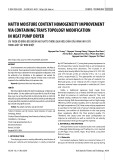
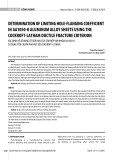

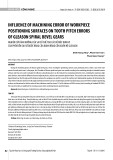

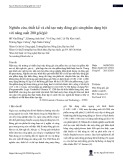
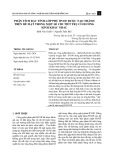
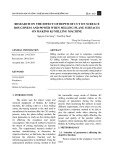

![Bài tập tối ưu trong gia công cắt gọt [kèm lời giải chi tiết]](https://cdn.tailieu.vn/images/document/thumbnail/2025/20251129/dinhd8055/135x160/26351764558606.jpg)














